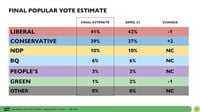As the sun set on April 27, 2025, Canada’s political landscape hung in the balance, with the nation poised for a pivotal election the following day. After a whirlwind campaign lasting 36 days, voters prepared to cast their ballots to determine the future of their government and, ultimately, the direction of the country.
The stakes were high as the country grappled with pressing issues such as the rising cost of living, the looming threat of U.S. President Donald Trump’s tariffs, and the recent tragedy in Vancouver that left at least 11 dead. This somber backdrop cast a shadow over the final pitches made by Prime Minister Mark Carney of the Liberal Party and Pierre Poilievre of the Conservative Party.
According to the final poll released by Abacus Data just before the election, the Liberals emerged as the favorites, capturing 41% of the likely voter support, closely followed by the Conservatives at 39%. The NDP trailed significantly with 10%, while the Bloc Québécois, People’s Party, and Greens garnered 6%, 3%, and 1% respectively. The poll was based on 2,500 interviews conducted from April 24 to 27, 2025, and indicated a shift in public sentiment as the campaign progressed.
Canadians approached the election with a sense of unease. A mere 31% believed the country was headed in the right direction, while 51% felt it was on the wrong track. This sentiment extended to perceptions of the global landscape, with only 14% expressing optimism about the world beyond Canada’s borders. The pervasive anxiety about economic stability was echoed in the poll results, where 45% of respondents identified reducing the cost of living as a top priority.
The campaign was marked by a dramatic shift in narrative following the resignation of former Prime Minister Justin Trudeau and the swift rise of Carney, who quickly positioned himself as a steady hand in turbulent times. The election became a referendum on whether Canadians preferred the continuity offered by the Liberals or the change promised by the Conservatives.
As the campaign drew to a close, the tragic events in Vancouver added a poignant layer to the electoral discourse. A man drove his SUV into a crowd celebrating a Filipino community festival, resulting in multiple fatalities and injuries. Both Carney and Poilievre expressed their condolences, with Carney stating, "Our hearts go to the friends and the families of those affected. It’s a terrible loss in a very tight-knit community." Poilievre echoed these sentiments, emphasizing the grief shared by all Canadians.
The candidates also faced the challenge of addressing the looming specter of Donald Trump, whose policies and threats loomed large over the election. The Liberal campaign centered around the argument that they were the only party capable of standing up to Trump and protecting Canadian interests. In contrast, the Conservative platform promised a bold new direction, focusing on economic recovery and addressing the cost of living.
In their final campaign speeches, both leaders made key promises aimed at addressing the concerns of Canadian voters. Carney’s Liberals pledged to reduce the marginal tax rate for the lowest income bracket by one percentage point, potentially saving families up to C$825 a year. They also proposed a C$5 billion investment in a Trade Diversification Corridor Fund to expand Canada’s trade relationships globally.
On the other hand, Poilievre’s Conservatives promised to cut the lowest income tax bracket by 15%, translating into a C$900 annual saving for each taxpayer. They also committed to eliminating the federal sales tax on new homes valued under $1.3 million, which could save home buyers up to C$65,000.
As the voting day approached, both parties aimed to solidify their bases while appealing to undecided voters. The Liberal Party’s strategy focused on leveraging Carney’s rising popularity, with a net-positive brand recognition of +12, while the Conservatives sought to close the gap with Poilievre’s improving favorability ratings.
Voter turnout was anticipated to play a crucial role in determining the election outcome. With younger voters historically less likely to participate, the campaign’s focus on engaging this demographic became paramount. The final poll indicated that turnout estimates were around 70%, with younger voters showing a preference for change, while older voters leaned towards stability.
As Canadians prepared to head to the polls on April 28, the atmosphere was charged with anticipation and uncertainty. The outcome of this election would not only decide the next Prime Minister but also shape the future of the nation amidst economic challenges and geopolitical tensions.
With the first results expected to roll in on April 29 at 4:30 am GMT, all eyes were on the electorate to see how they would respond to the candidates’ contrasting visions for Canada’s future. Would they opt for the steady hand of Carney, or take a chance on Poilievre’s promises of change? Only time would tell as the nation braced for what could be a historic election.





